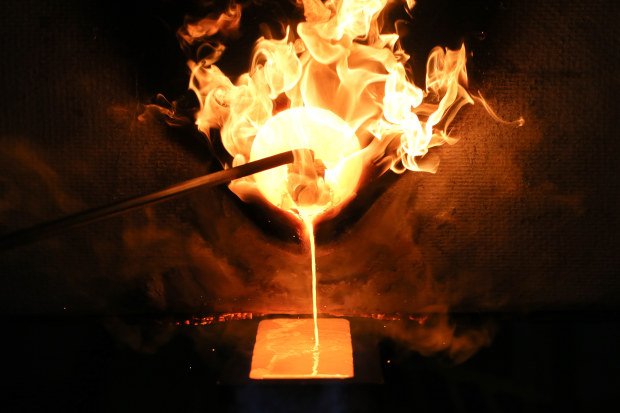...this was the sort of headlines I warned here back in mid April when the commodity bull rally was in fifth gear, but many had been having too much of the party to want to heed the warnings. In April, I saw dark clouds from a looming recession and what that meant for demand destruction...but we were sold by mainstream that commodities shortage and supply constraint would ensure that prices stay higher for longer.
...just when I saw an equity meltdown early in the year, I firmly always believed that the time to take the pedal off the gas is when the sector is enjoying unbridled exuberance and dark clouds start appearing no one wanted to acknowledge and simply shrug away.
...the majority would rather wait for this sort of headline below before acting. But of course this is already After the Event. And they would be trapped in the downward spiral.
...right now while the market is concern over recession , they have not yet fathom what could potentially happen when recession strikes amidst higher and rising rates. Decision pushed down the road for another day would likely become even more difficult as days past. This is why this thread had emphasised No Denial No Procrastination. Doing Nothing IS Doing Something.
Recession fears unleash carnage across commodity markets
Alex GluyasMarkets reporter
Jul 6, 2022 – 10.26am
Commodity prices collapsed and the Australian dollar plunged to a two-year low as anxiety about a global recession zapping demand for raw materials hit fever pitch.
Traders were spooked as the US 10-year and two-year bond yields inverted again overnight, flashing a recession alert. That meant short-term rates briefly exceeded long-term rates, indicating a growth shock ahead.
Fears of a recession failed to ignite safe haven buying in gold, which fell to its lowest level in more than six months. Bloomberg
Oil posted its worst trading session in nearly three months as expectations for weaker demand overpowered concerns about tight supply.
West Texas Intermediate crude futures settled below $US100 a barrel after falling more than 8 per cent, the most since March 9. Brent crude futures fell more than 9 per cent, dipping below $US103 a barrel.
The S&P/ASX 200 opened 0.4 per cent lower at 6601.8 as the energy sector dived 3.5 per cent and materials stocks dropped 3.4 per cent. Fortescue tumbled 4.4 per cent to $16.56 and Rio Tinto declined 4 per cent to $96.72.
Citi warned a recession could cause crude oil to spiral to $US65 a barrel by the end of the year and further decline to $US45 by the end of 2023, absent intervention by OPEC+, and a decline in short-cycle oil investment.
The carnage across commodity markets dragged the $A to a two-year low of US67.62¢ before settling at US67.93¢, down 1 per cent. The safe haven US Dollar Index jumped 1.3 per cent to 106.5, a new two-decade high.
On Tuesday, the Reserve Bank of Australia raised the official cash rate half a percentage point, for a second straight month, to 1.35 per cent.
“The fall in oil prices is telling us a huge amount about fears of demand destruction which are linked to deepening concerns about not just a US recession, but a global recession,” said Ray Attrill, global head of FX strategy at National Australia Bank.
“That’s an environment where the Australian dollar never performs well; when global concerns are at the fore.”
Copper, which is widely viewed as an economic bellwether, dropped as much as 5.1 per cent to $US7597 a tonne on the London Metal Exchange, its lowest since early December 2020. It settled at $US7670 per tonne.
Other metals followed suit, as aluminium fell 2.9 per cent and tin dropped 2.3 per cent.
Sentiment also took a hit from news that Shanghai has launched mass COVID-19 testing in nine districts after detecting cases over the past two days, reigniting concerns about another lockdown in China’s financial hub.
This weighed on iron ore prices, with the August contract in Singapore dropping $US1 to $US108.70 per tonne. The spot price rose 4 per cent overnight to $US114.30 a tonne.
“If the testing uncovers more cases, Shanghai may see restrictions increase, weighing on China’s economic growth and commodity demand,” said Vivek Dhar, Commonwealth Bank’s mining and energy analyst.
The bearish mood across markets ultimately overwhelmed any positivity sparked by reports on Tuesday that the Biden administration is considering easing tariffs on Chinese consumer goods.
Wall Street was swept up by the chaos across commodity markets, with the Nasdaq gaining 1.8 per cent and the S&P 500 rising 0.2 per cent as technology stocks led a mid-session recovery and cyclical stocks were punished. The Dow Jones was the only major benchmark to fall, easing 0.4 per cent.
Energy crisis
European equities bore the brunt of the selling as the Euro Stoxx 50 plunged 2.7 per cent, and the FTSE 100 Index declined 2.9 per cent.
This was attributed to European gas prices surging to a four-month high as oil workers in Norway launched a strike due to a dispute over wages. The strike was forcibly concluded with government intervention.
“The energy crisis overlay could explain the more bearish tone evident in Europe,” National Australia Bank analysts said.
Fears about the European economy, combined with US dollar strength, dragged the euro to a 20-year low against the greenback. The European currency is moving closer to parity with the US dollar, with 1 euro trading at about $US1.027.
- Forums
- ASX - General
- Its Over
Its Over, page-13458
- There are more pages in this discussion • 8,123 more messages in this thread...
You’re viewing a single post only. To view the entire thread just sign in or Join Now (FREE)





